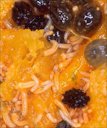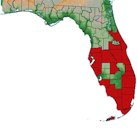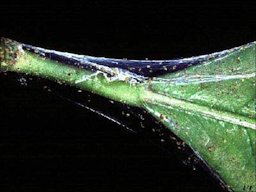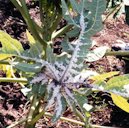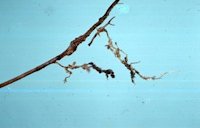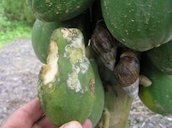| Papaya Pests | ||||||||||||||||||||||
|---|---|---|---|---|---|---|---|---|---|---|---|---|---|---|---|---|---|---|---|---|---|---|
| Back
to Papaya Page  Fig.
1 Fig.
1 
Adult female papaya fruit fly, Toxotrypana curvicauda 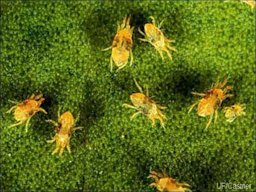 Fig.
5 Fig.
5 
Twospotted spider mites, Tetranychus urticae 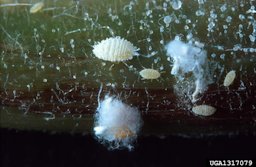 Fig. 8 Fig. 8 
Several female papaya mealybugs (1/16 to 1/8 inch long) and two web masses on a stem of a red potato sprout  Fig.
12 Fig.
12  Life stages of reniform nematode, Rotylenchulus reniformis. Ranging from left to right is egg, juvenile, young female with swollen body, and mature female in kidney shape. 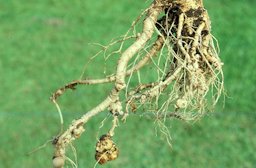 Fig.
13 Fig.
13  Root knot galls caused by Meloidogyne nematodes 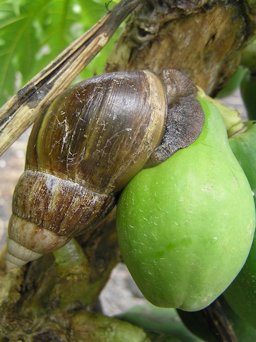 Fig. 15  Papaya (Carica papaya): Giant African snail (Achatina fulica)
| Papaya
Fruit Fly
Toxotrypana curvicauda Gerstaecker (Fig.1) The papaya fruit fly, Toxotrypana curvicauda Gerstaecker, is the principal insect pest of papaya (Carica papaya L.) throughout the tropical and subtropical areas of the New World. The insect was introduced into Florida in 1905, most likely from the West Indies on papaya shipments. It first became established in the Florida Keys and Miami, then spread throughout the state wherever papayas are grown. Papaya fruit fly larvae and adults have been found in Florida in every month of the year. 1
Fig. 2. Larvae of the papaya fruit fly, Toxotrypana curvicauda, in papaya Fig. 3. Fruit flies on fruit Fig. 4. Distribution of the papaya fruit fly, Toxotrypana curvicauda, in Florida Further Reading Papaya Fruit Fly, Toxotrypana curvicauda Gerstaecker, University of Florida pdf Papaya Fruit Fly, University of Florida How to Protect your Papaya Fruit from the Papaya Fruit Fly, Garden Web Forum Two-Spotted Spider Mite Tetranychus urticae (Fig.5) The two-spotted spider mite is oval in shape, about 0.5 mm long, and may be brown or orange-red, but a green, greenish-yellow or an almost translucent color is the most common. All mites have needle-like piercing-sucking mouthparts. Spider mites feed by penetrating the plant tissue with their mouthparts and are typically found on the underside of the leaf. Spider mites spin fine strands of webbing on the host plant, hence their name. When two-spotted spider mites remove the sap, the mesophyll tissue collapses and a small chlorotic spot forms at each feeding site. Continued feeding causes a stippled-bleached effect on the upper surfaces of leaves and later, the leaves turn yellow, gray or bronze. Complete defoliation may occur if the mites are not controlled. 3
Fig. 6. Webbing produced by twospotted spider mites, Tetranychus urticae Fig. 7. Paracoccus marginatus different cycles Further Reading Two-Spotted Spider Mite, University of Florida pdf Papaya Whitefly Trialeuroides variabilis Female whiteflies lay yellow oval eggs, which appear dusted, singly on the undersides of leaves. The nymphs go through three instars. The first instar or crawler has well-developed legs and is the only mobile immature life stage. After finding a suitable feeding site on the lower surface of a leaf, the crawlers insert their mouthparts, begin feeding, and usually do not move again while in the nymphal stage. The subsequent instars are flattened, oval, and scale-like. Whiteflies in the pupal stage are more convex, with large, conspicuous red eyes. 3 Mealybugs Paracoccus marginatus (Fig.8) The papaya mealybug, Paracoccus marginatus Williams and Granara de Willink, is a small hemipteran that attacks several genera of host plants, including economically important tropical fruits and ornamentals. The papaya mealybug was discovered in Manatee and Palm Beach counties in Florida in 1998 and subsequently spread rapidly to several other Florida counties. 4
Fig.9. Distribution of the papaya mealybug, P. marginatus as of May 2003 Fig. 10. Papaya leaf infestation of the papaya mealybug, P.marginatus Fig. 11. Papaya fruit infestation and damage caused by the papaya mealybug Further Reading Papaya Mealybug, Paracoccus marginatus, University of Florida pdf Root Knot Caused by Meloidogyne nematodes (Fig.14) Plant-parasitic nematodes are microscopic roundworms, found in soils, which primarily attack plant roots. General signs of nematode damage include stunting, premature wilting, leaf yellowing, root malformation, and related signs characteristic of nutrient deficiencies. Stunting and poor stand development tend to occur in patches throughout the field as a result of the irregular distribution of nematodes within the soil. Species of nematodes reported to be associated with papaya plants include Rotylenchulus reniformis, Meloidogyne spp., Helicotylenchus dihysteria, Quinisulcius acutus, and Criconemella spp. The first two genera are by far the most damaging to papaya. 3 R. rotylenchulus (reniform nematode) is small in size and does not traverse distances of more than a few inches during its life. The nematodes are primarily spread through cultivation and surface runoff or through irrigation water. After molting several times, mature females penetrate the root cortex and become sedentary. Phloem feeding by the nematode creates giant cells, which are centers of high metabolic activity that compete with other parts of the plant for nutrients. The portion of the body that remains outside the root enlarges and becomes kidney-shaped. After mating, the female secretes a gelatinous substance around her body into which approximately 100 eggs are laid. When roots are washed clean, these egg masses appear like grains of sand. A complete life cycle is possible in about 25 days. 3 Papaya is susceptible to galling by the four common species of root-knot nematode. Many of the aspects of root-knot attack are similar to the reniform nematode. However, unlike reniform nematodes, the female root-knot nematode and associated egg-mass are embedded in the root tissue. Each egg mass may contain 350 eggs and 14–17 generations are possible in a year under subtropical conditions. In addition to the metabolic drain from feeding as described above, root systems may be reduced by terminal root infections, which cause a slight swelling and cessation of further elongation. Nutrient and water uptake are also impaired. 3
Further Reading Reniform Nematode, Rotylenchulus reniformis Linford and Oliveira, University of Florida pdf Giant African land snail Achatina (Lissachatina) fulica Giant African land snail, Achatina (Lissachatina) fulica, is considered by some to be one of the most damaging snails in the world. It has been observed to feed on at least 500 different types of plants, many of them crops. It is thought to have originated in East Africa, but has since spread through many countries in Southeast Asia and islands in the Pacific Ocean, including the Hawaiian Islands. More recently, this mollusc gained access to South America (Brazil) and the Caribbean islands of Martinique, Guadeloupe, Saint Lucia, Barbados and Saint Martin/ Saint Maarten. In early September 2011, it was found in Miami-Dade County of southern Florida. This is not the first occurrence of giant African snail in Florida. In 1966, a Miami, FL, child smuggled three giant African snails into south Florida when he returned from a trip to Hawaii. His grandmother eventually released the snails into her garden. Seven years later, more than 18,000 snails had been found along with scores of eggs. It was eventually eradicated, but it took 10 years at a cost of $1 million to eliminate this invader. Florida is now once again faced with an invasion by this snail. 5 The molllusc increases fruit and stem blight caused by Phytophthora palmivora as the snail spreads the pathogen contact with its body. 6
Fig. 16. African snails (A. fulica) and their feeding injury to papaya fruits. The whitish mycelium is Phytophthora palmivora. Oct 8, 2021 Tallahassee, Fla. — This week, Florida Agriculture Commissioner Nikki Fried and the Florida Department of Agriculture and Consumer Services (FDACS) Division of Plant Industry (DPI), along with the U.S. Department of Agriculture (USDA), announced the eradication of the giant African land snail (GALS) from Broward and Miami-Dade counties. This eradication announcement marks only the second time this pest has been eradicated in the world, both in South Florida. 7 Further Reading (Giant) African snail (Achatina fulica) | |||||||||||||||||||||
| Bibliography 1 Lane Selman, H., et al. "Papaya Fruit Fly (suggested common name), Toxotrypana curvicauda Gerstaecker (Insecta: Diptera: Tephritidae)." Featured Creatures, Entomology and Nematology Dept., UF/IFAS Extension, EENY-021 (IN148), Original pub. Mar. 2001, Revised Apr. 2015 and May 2021, AskIFAS, edis.ifas.ufl.edu/in148. Accessed 2 Feb. 2017, 9 Aug. 2020, 24 Feb. 2022. 2 Fasulo, Thomas R,. and H. A. Denmark. "Twospotted Spider Mite, Tetranychus urticae Koch (Arachnida: Acari: Tetranychidae)."Featured Creatures, Entomology and Nematology Dept., UF/IFAS Extension, EENY-150 (originally published as DPI Entomology Circular 89), Original pub. Aug. 2000. Reviewed Oct. 2012, Jan. 2016, AskIFAS, doi.org/10.32473/edis-in307-2000, edis.ifas.ufl.edu/in307. Accessed 31 Mar. 2014, 9 Aug. 2020. 3 Mossler, Mark A., and Jonathan Crane. "Florida Crop/Pest Management Profile: Papaya." Horticultural Sciences Dept. UF/IFAS Extension, CIR 1402, Original pub. Sept. 2002, Revised Nov. 2009, Reviewed July 2013, Archived, AskIFAS, edis.ifas.ufl.edu. Accessed 2 Feb. 2017, 9 Aug. 2020. 4 Walker, Alison, et al. "Papaya Mealybug, Paracoccus marginatus Williams and Granara de Willink (Insecta: Hemiptera: Pseudococcidae)." Featured Creatures, Entomology and Nematology Dept., UF/IFAS Extension, Original pub. Aug. 2003, Revised May 2021, AskIFAS, edis.ifas.ufl.edu/in579. Accessed 2 Feb. 2017, 9 Aug. 2020, 25 Feb. 2022. 5 Capinera, John L. "Giant African Land Snail in Florida." Entomology and Nematology Dept. UF/IFAS Extension, ENY-512, Original pub. Oct. 2011, Revised Feb. 2021, AskIFAS, edis.ifas.ufl.edu/in904. Accessed 12 Feb. 2017, 9 Aug. 2020, 25 Feb. 2022. 6 Nelson, Scot. "Injuries Caused by the Giant African Snail to Papaya." College of Tropical Agriculture and Human Resouces, University of Hawai'i at Mānoa, June 2012, CTAHR, ctahr.hawaii.edu. Accessed 12 Feb. 2017. 7 "VIDEO: Florida Eradicates Giant African Land Snail." Press Release Oct. 2021, Florida Department of Agriculture and Consumer Services, www.fdacs.gov/News-Events/Press-Releases/2021-Press-Releases/VIDEO-Florida-Eradicates-Giant-African-Land-Snail. Accessed 24 Feb. 2022. Photographs Fig. 1 Caldwell, Doug. "Adult female papaya fruit fly, Toxotrypana curvicauda Gerstaecker." Featured Creatures, Entomology and Nematology Dept., UF/IFAS Extension, AskIFAS, edis.ifas.ufl.edu/in148. Accessed 8 Apr. 2014. Fig. 2 Bauer, Scott. "Larvae of the papaya fruit fly, Toxotrypana curvicauda Gerstaecker, in papaya." USDA, Entomology and Nematology Dept., UF/IFAS Extension, AskIFAS, edis.ifas.ufl.edu/in148. Accessed 8 Apr. 2014. Fig. 3 Nelson, Scot C. "Fruit Fly." Hawai'i Plant Disease, (CC BY-NC-SA 2.0), hawaiiplantdisease.net. Accessed 31 March 2014. Fig. 4 Steck, G. J., and B. D. Sutton. "2014 Distribution of the papaya fruit fly, Toxotrypana curvicauda Gerstaecker, in Florida." Division of Plant Industry, 2014, AskIFAS, edis.ifas.ufl.edu/in148. Accessed 10 Apr. 2014. Fig. 5 Castner, J. "Twospotted Spider Mite, Tetranychus urticae Koch (Arachnida: Acari: Tetranychidae)." Featured Creatures, Entomology and Nematology Dept., UF/IFAS Extension, AskIFAS, edis.ifas.ufl.edu/in307. Accessed 8 Apr. 2014. Fig. 6 "Webbing produced by twospotted spider mites, Tetranychus urticae Koch." Featured Creatures, Entomology and Nematology Dept., UF/IFAS Extension, AskIFAS, edis.ifas.ufl.edu/in307. Accessed 10 Apr. 2014. Fig. 7 Meyerdirk, Dale. "Paracoccus marginatus Williams & Granara de Willink Different Cycles." USDA APHIS PPQ, no. 2200019, 2006, Bugwood.org, (CC BY 3.0 US), bugwood.org. Accessed 10 Apr. 2014. Fig. 8 Peggy Greb, Peggy. "Several female papaya mealybugs (1/16 to 1/8 inch long) and two web masses on a stem of a red potato sprout." USDA Agricultural Research Service, no. 131079, 2006, Bugwood.org, (CC BY 3.0 US), bugwood.org. Accessed 10 Apr. 2010. Fig.9,10 Meyerdirk, Dale. "Distribution of the papaya mealybug, Paracoccus marginatus Williams and Granara de Willink, as of May 2003 and Papaya leaf infestation of the papaya mealybug, Paracoccus marginatus Williams and Granara de Willink." National Biological Control Institute, Featured Creatures, Entomology and Nematology Dept., UF/IFAS Extension, AskIFAS, edis.ifas.ufl.edu/in579. Accessed 31 Mar. 2014. Fig.11 Meyerdirk, Dale. "Papaya fruit infestation and damage caused by the papaya mealybug, Paracoccus marginatus Williams and Granara de Willink." National Biological Control Institute, Featured Creatures, Entomology and Nematology Dept., UF/IFAS Extension, AskIFAS, edis.ifas.ufl.edu/in579. Accessed 31 Mar. 2014. Fig. 12 Wang, Koon-Hui. "Life stages of reniform nematode, Rotylenchulus reniformis Linford & Oliveira." Horticultural Sciences Dept. UF/IFAS Extension, AskIFAS, edis.ifas.ufl.edu. Accessed 11 Apr. 2014. Fig. 13,14 Nishijima, Wayne. "Root-knot (Meloidogyne sp., nematode)." Hawai'i Plant Disease, 2006, hawaiiplantdiseases.net. Accessed 11 Apr. 2014. Fig. 15,16 Nelson, Scot C. "Papaya (Carica papaya): Giant African snail (Achatina fulica)." Pest and Disease Image Gallery, University of Hawai'i, 2017, Flickr, (CC BY-SA 2.0), flickr.com. Accessed 12 Feb. 2017. Published Feb. 2014 LR. Last update 25 Feb. 2022 LR | ||||||||||||||||||||||
